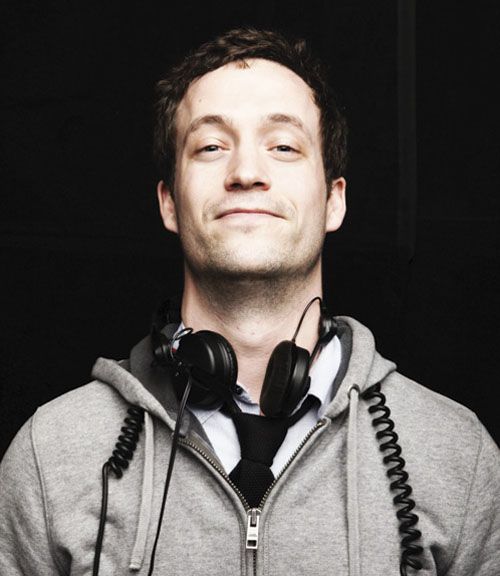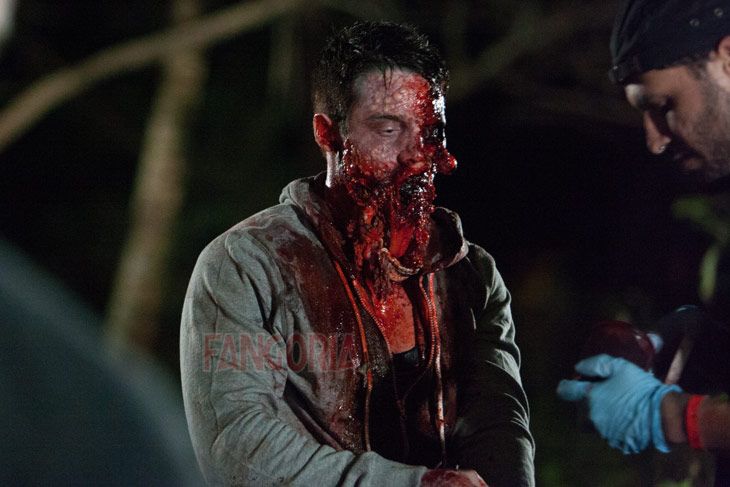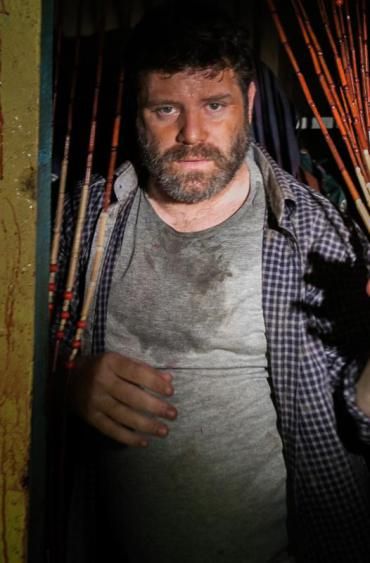When your day job involves writing and drawing the adventures of some of the world’s best-known superheroes, it’s difficult to imagine what kind of gigs could lure you away from the drawing board – but directing a movie is one of them.
Kaare Andrews has established himself as one of the most inventive and dynamic artists in comics, known for such high points as 2004’s Spider-Man: Reign and his current stint on Iron Fist: The Living Weapon. But the Canadian artist has also brought his keen visual sense to filmmaking through shorts, PSAs, the 2010 thriller Altitude and a segment of the horror anthology The ABCs of Death. His most recent directorial effort allowed him to tackle a new installment of one of horror’s cult favorites, Eli Roth’s Cabin Fever.
Seeking to rehabilitate the franchise after a 2009 sequel missed the mark, Andrews’ Cabin Fever: Patient Zero turns back the clock for a prequel that reveals the origins of the vicious virus that ate the flesh off the original film’s collegiate vacationers. With the film now available for digital download, Andrews spoke with Spinoff Online about his mindset in taking on the established franchise, the challenges of shooting in the Dominican Republic, working with a genre legend who proved infinitely patient, and his synergistic expectations as Netflix’s Iron Fist series moves closer to reality.
Spinoff Online: Taking on a franchise like this that’s established, but to also put your own stamp on it – how did you want to approach this material?
Kaare Andrews: Let me be completely honest: It was a little daunting! The first movie I really enjoyed, watching it in the theaters, then brought it home and enjoyed the special DVD edition – watched all the commentaries, all the special features. I really thought it was a cool movie. It’s a little daunting to follow up a successful cult hit like that. But then, the sequel proved to be problematic, I think, for everyone involved. So the filmmakers themselves weren’t quite happy with what had happened, and then the audience didn’t quite respond to it. As a cult hit, followed by a bit of a disaster – maybe that’s too strong a word – a bit of a debacle, and then to try to recover and exist in that same franchise was an interesting situation. It was like, “How do we do that?” And I think the only answer is, “Well, you just have to own it.” You have to own it completely and try to get your own thing. And the cool thing was, it wasn’t the third movie, per se, in a string of three. It was its own story, in its own environment, with its own characters, and it’s kind of a gentle story – along the lines of what I think is going to be happening with the Star Wars movies, with a stand-alone story in the same universe. So that’s how I looked at it: It was just somewhere in between doing a remake, where I was bound to continue a story, characters, situation -- it was a new situation in the same world.
At this stage of your filmmaking career, what were the fresh challenges as you went into production? What were the bars you had set to reach for yourself?
This one was interesting because we shot it in the Dominican Republic, so it was a very low-budget movie but we shot in the exotic location. Half our crew – which was an amazing crew, lovely people – but half of them have never even worked on a TV commercial before, or a music video. So it was like half the crew had no idea what they were doing. That kind of a machine was a little different than I'd worked before. I’m used to working with maybe less-experienced people, but people who know the jobs and are hungry. They just need to work in a foreign landscape, with the foreign languages, with a foreign crew, this was a job to them. They may or may not have understood all of them. Again, it was a great experience to work with them, but half of the people were fish out of water. It was like a new thing to them. The other thing I was really excited about was working with practical special makeup effects. I love that stuff. So it was a way for me to tap into that passion of mine. I’ve studied makeup, and would read Dick Smith’s Do-It-Yourself Monster Makeup Handbook and Tom Savini’s Bizzaro! They were really rock stars when I was growing up. I need to homage that period of filmmaking that embraced the physical nature of film blood and real prosthetics, and real sculpts. This is not a CG movie; this is a goopy, slimy, gory movie. So I was excited to just have that experience.
Given your background as an graphic artist, how much visual prep are you able to put down on paper before you start a movie? Or are you able to proceed mostly from what’s in your head?
I like to get things down on paper. Art is visual communication. The real advantage you have when you’re a director and you draw is you can draw things and show people exactly what you want. Not just the composition the makeup effects – all the stuff. I did some set designs, to design the looks of the makeup. I assembled lookbooks for wardrobe. I drew storyboards. I even did a couple visual-effects shots. The only thing holding me back is really time. And when you’re one man, and you’re also directing the movie, you don’t have a lot of time. But every minute, I was drawing. We were a tiny movie, but I really wanted to create as big of an experience as I could with our resources, and I think it’s something we succeeded at. Even when I’m directing, I feel like at my best I’m painting actors on set. I feel like when I’m in my groove and I’m directing a scene, it’s like the actors and crew are paints and brushes, and I’m able to paint those scenes. I look at the process in visual terms. It's all kinds of things that bleed into each other. It’s fun to apply those skills to filmmaking.
I don’t think sex and gore are intermingled in any other horror franchise as much as they are in Cabin Fever, so tell me about approaching that very distinct aspect -- getting the balance of sex and gore just right.
The first Cabin Fever movie, when you watch it, it’s really Porky's -- like a sex comedy in that first act. Ours was a little less so, but I wanted to push those elements a little bit to have it feel like a Cabin Fever movie. We didn’t have the same characters. We didn’t have the same story. We didn’t have interconnecting events to those other Cabin Fever movies, so I wanted to have some of the elements feel like they belonged in a ‘Cabin Fever’ movie. I also tried to push the humor a little bit. The movie is pretty serious and pretty dark, but I spent some time enhancing and doing some improvisation and trying to get some more humor out of it to make it a little more of a Cabin Fever movie. I think horror in general attracts to our two basic instincts of human survival, and that is killing to eat, and intercourse to reproduce, to continue the species. Horror is just kind of an exploration of those two basic instincts gone awry, gone wrong. I think even in the more classy “horror” movies, my favorites like The Shining or The Exorcist, there’s still little Regan in The Exorcist plunging a crucifix into her crotch yelling “Fuck me, fuck me.” Or like in The Shining, Jack Nicholson stumbles across a naked woman in the bathtub and starts making out with her, and she turns into this bitter old hag. So I think these are two base components to horror. We just chose to use them as more “B-movie” or kitschy, in the best sense of the word, not that I’m talking down to the genre, but in a fun, stupid romp and less of like a psychological horror. More of an active, visceral components to the movie.
When you’ve got an actor in your cast like Sean Astin, what percentage of your time is devoted to directing him in the movie, and how much is devoted to asking him questions about every great movie that he’s been in?
Well, I was so busy I didn’t get time to give Sean the Q&A [laughs]. But the whole crew loved him, and would ask him so many questions and he was only happy to answer every one of them. There were no hard feelings about those movies. If you would imagine some actors after all those years would be like, “Enough with those questions!” But he loved it and was happy to sign autographs with the crew and talk to everyone about it. Sean was really cool; he brought his A-game. I asked him to show up in a beard, and he gained a little bit of weight for the role to give him both a softer, fatherly appearance but also a more menacing physicalization, so both edges of his transformation: the beginning and the end of the transformation of his character. I was going over the footage in the editing room, and I was constantly impressed but what he was doing on the set, and what he gave me to work with in the editing room. I’d love to work with Sean again, he was a cool guy.
I just want to jump into your comic book work a bit. I’m enjoying Iron Fist, and I’m curious what you have planned ahead, and also if you’ve had any chance to get a little synergistic with the planned Netflix series that’s coming up.
I have spent three issues kind of putting him through hell, and it’s only going to get worse. Every issue is going to be another level of hell and level of descent. I really think that heroes need to be tested, and superheroes need to be super-tested. You just need to beat these characters beyond the point they could ever survive it, and then watch them try to survive it. Those are my favorite superhero stories. So I’m having a lot of fun just taking everything that he knows about himself and his world and destroying it and watching him deal with it, and seeing if he’ll have the strength to rise out of it. And I’m not involved with Netflix at this point, I don’t know what their plans are. I’ve just focused on the comic book. To be honest, knowing how things work I think it’s probably a little early in the game for Marvel to really know what to do with Netflix. I think they’re probably focusing on the Daredevil, and then letting the Iron Fist kind of bubble somewhere in the background for now. But I’m super-excited to see what they do with this character. Spending all this time focusing on him, I’ve really grown to love and appreciate him in every aspect. I can only image the opportunities that could happen from a character like this in a Netflix show.




